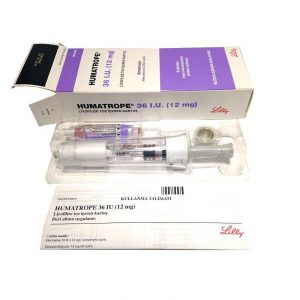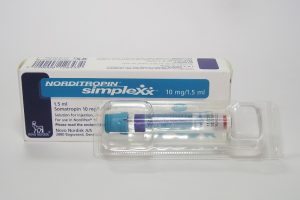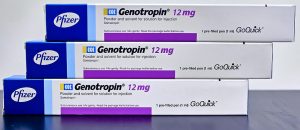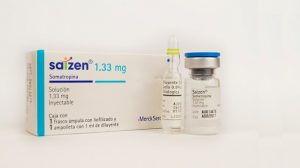Human Growth Hormone is perhaps one of the newest compounds used by athletes and bodybuilders looking to obtain a larger edge in the area of physique and performance enhancement. It must first be made clear that Human Growth Hormone is not an anabolic steroid. Human Growth Hormone is what is known as a protein hormone (or a peptide hormone) that is naturally and endogenously produced by the human body and secreted at the pituitary gland. The neurosecretory cells of the hypothalamus release a hormone known as GHRH (Growth Hormone Releasing Hormone, AKA Somatocrinin) and another hormone known as GHIH (Growth Hormone Inhibiting Hormone) into the pituitary gland, which then manufactures and releases its Human Growth Hormone storage into the bloodstream. Human Growth Hormone belongs to the Somatotropin family of protein hormones, making it a very close relative to the hormone Prolactin, which also belongs to the Somatotropin family of hormones. The total Somatotropin family includes: CSH1, CSH2, CSHL1, HGH (Human Growth Hormone), PRL (Prolactin), and hGH-V. Human Growth Hormone consists of a structure of 191 amino acids.
Human Growth Hormone, as its name would suggest, is an important hormone in the role of many different growth mechanisms and functions in the human body. However, Human Growth Hormone’s activity is not limited to just this function – it possesses a whole myriad of different functions and effects on many different processes of the body, including regulating certain aspects of the metabolism, providing cellular regeneration and growth, as well as healing and repair and more. Many of Human Growth Hormone’s functions are well known, but it also possesses properties and functions that are still as of yet known or not very well understood. Human Growth Hormone’s primary effects on growth functions of the body are in three primary areas: bone growth, skeletal muscle growth, growth of internal organs, and the healing/growth/repair of connective tissue such as tendons, ligaments, and joints. In terms of its effects on metabolism, it supports the efficient functions of protein, carbohydrate, fat, and vitamin/mineral metabolism.
Within the medicine, Human Growth Hormone has been used successfully as a treatment to many different types of disorders and ailments. The first and foremost use of HGH medically is for the treatment of pituitary deficient dwarfism, a condition in which individuals do not grow properly due to a lack of endogenous Human Growth Hormone production. This is most frequent during childhood or adolescence, where synthetic Human Growth Hormone is administered in order to increase growth as much as possible prior to the middle stages of adolescence whereby the potential for growth becomes increasingly limited. It is also utilized for similar conditions in adults as well. Medically, Human Growth Hormone is also utilized for the treatment of Human Growth Hormone deficient adults, whereby adults produce insufficient levels of GH, and synthetic exogenous Human Growth Hormone is administered in order to restore levels into the normal range (preferably into the range of what a young adult would possess so as to restore youthfulness and exhibit anti-aging effects so commonly attributed to Human Growth Hormone). Lastly, exogenous Human Growth Hormone therapy is used in the treatment of AIDS/HIV related muscle wasting (or as a result from many other diseases). There are other conditions that Human Growth Hormone is occasionally utilized for treatment as well, such as the promotion of accelerated healing in burn victims.
History of Human Growth Hormone
Somatropin is the name for synthetic Human Growth Hormone synthesized by way of recombinant DNA (rDNA) synthesis technology whereby viruses are inserted with the genetic code (i.e. blueprint) for the creation of GH. Petri dishes that contain strains of e.coli bacteria are then infected by the bacteria (the genetic code is injected/inserted into the bacteria by the viruses). Essentially, these bacteria are now ‘tricked’ into manufacturing human growth hormone as their sole purpose as determined by their new genetic programming. The resulting Somatropin (rHGH, AKA recombinant Human Growth Hormone) is 100% exactly identical to the Human Growth Hormone that is endogenously manufactured by the pituitary gland in every human being. There is no difference at all between rHGH and endogenously naturally manufactured HGH. This is how Human Growth Hormone is manufactured today, and recombinant DNA synthesis technology was successfully designed in the 1979 by Genentech[1] and has been used ever since for the synthetic manufacturing of all kinds of complex proteins and protein hormones.
However, this is not how Human Growth Hormone was manufactured and used prior to the 1980s. The original Human Growth Hormone preparations prior to rDNA technology in the 1980s were by way of Human Growth Hormone extracted from the pituitary glands of human cadavers. With this technique, 1mg of Human Growth Hormone could be successfully extracted from the pituitary of the dead body. It was in 1958 when the very first use of Human Growth Hormone extracted from cadavers was published[2]. Shortly thereafter, HGH of cadaver origin was marketed until 1985 when rDNA technology replaced it.
More significant, however, was the fact that in 1985 the FDA made the decision to ban cadaver-derived Human Growth Hormone due to the fact that during the extraction process, it was impossible to filter out 100% of all other possible contaminants. The result was that various batches of cadaver-derived Human Growth Hormone were found to be contaminated with prions (certain misfolded proteins that cause neurological damage) which ended up causing Creutzfeldt-Jakob’s Disease (CJD). This was a very fatal brain disease that several Human Growth Hormone treated patients had succumbed to. Approximately 26 patients that were administered cadaver-derived Human Growth Hormone had contracted CJD[3].
Shortly thereafter, as mentioned above, rDNA technology had been developed and this manner of synthesis resulted in a 100% pure hormone product without any possibility of contaminants. The very first synthetic rDNA marketed Human Growth Hormone preparation was known as Somatrem and Protropin. Protropin contained a slight variation in its peptide structure that deviated from Human Growth Hormone, but was almost 100% identical and exhibited all of the same effects in the body. In 1987, Vitrum pharmaceuticals of Sweden had developed the first synthetic Human Growth Hormone molecule that was 100% identical to that of naturally endogenously produced Human Growth Hormone in the body[4].
Growth Hormone Effects In Different Tissues
HGH has displayed a vast, broad, and diverse range of effects. It is a hormone that has been found to be anabolic in muscle tissue, demonstrated to increase both the size (hypertrophy) and number of muscle cells (hyperplasia). The interesting fact about Human Growth Hormone is that its ability to generate a far greater amount of hyperplasia over hypertrophy is very favorable among athletes and bodybuilders, as an increased number of muscle cells (hyperplasia) over an increase in the size of muscle cells (hypertrophy) is always favored due to the fact that newly created muscle cells remain permanently (more or less). The size gains as a result from hyperplasia will remain indefinitely following these growth effects.
Human Growth Hormone also possesses the effect of promotion of cell regeneration, re-growth, and healing in every single cell type in the human body with the exception of the majority of cells in the eyes and brain. This is beneficial for individuals who possess debilitations and/or diseases in which organ failure is a possibility, but organ transplants are not an ideal option. The use of Human Growth Hormone can effectively heal, for example, and individual who possesses kidney or liver failure and at the very least maintain normal functioning of these organs through its cellular regeneration and growth capabilities. This is also why HGH will generally result in larger organs (due to the increased cellular growth), and is a perfect example of why individuals with various organ failure typically possess organs that are far smaller (due to the extensive cellular death of the organ’s cells) than individuals who otherwise possess healthy organ function.
Human Growth Hormone’s metabolism effects include its major effect of shifting the human body’s preference of energy source from carbohydrates to lipids (fats). As a result, Human Growth Hormone use will commonly result in rising blood sugar levels (known as a diabetogenic effect). This effect is, of course, dose-dependent and directly correlated with doses. Excessive Human Growth Hormone doses or periods of use can possibly result in the beginning of type-2 diabetes. However, through its manipulation of energy sources from carbohydrates to body fat as the preferred source, the fat loss effects can be very dramatic and as a result will also decrease cholesterol levels. Human Growth Hormone also tends to deplete potassium, phosphorous, and sodium levels, which should be kept in mind by the user (proper supplementation with these minerals is advised especially with higher Human Growth Hormone doses). Human Growth Hormone also tends to have a lowering effect on circulating levels of T3 (thyroid hormone), which can temporarily disrupt metabolism. Once again, this is a dose-dependent effect.
Overall, Human Growth Hormone acts upon receptors located on muscle, cells, bone, and fat tissue, signaling these different cell and tissue types to engage in growth and fat loss. Its effects on metabolism also result in an increase of hepatic (liver) gluconeogenesis (creation of glucose), and its role in preventing cells from utilizing this fuel source in favor of lipids instead. The fact of the matter is that Human Growth Hormone’s effects are all essentially governed by the protein hormone IGF-1 (Insulin-like Growth Factor 1). GH travels to the liver where it signals the liver cells to begin production and secretion of IGF-1, a very potent growth hormone that has been proven to be very anabolic in muscle tissue. It must be understood, however, that IGF-1 possesses properties and effects that are very much the opposite of Human Growth Hormone (for example, IGF-1 tends to increase fat retention and increase glycolysis (consumption of glucose as fuel).
Controversy Concerning the Effectiveness of Human Growth Hormone
A hotly debated topic is that of whether or not Human Growth Hormone is truly effective in terms of physique and performance enhancement, and if it is indeed a worthwhile endeavor and investment for those looking to enhance their physique and/or athletic performance. Although this will be discussed further in the Human GH doses and cycles section of this profile, the truth of the matter is that several studies have indeed demonstrated that Human Growth Hormone use results in some pleasing weight and lean mass gains, it is a poor choice for strength gaining[5] [6] [7].
Furthermore, it has been demonstrated that Human Growth Hormone utilized alone (without anabolic steroid stacked with it) will result typically only in dramatic fat loss, and that in order to experience the dramatic muscle mass gains, one must either utilize Human Growth Hormone with anabolic steroids or Human Growth Hormone must be utilized long-term (at least 6 months of consistent use).
Studies on AIDS/HIV patients that are administered Human Growth Hormone have demonstrated that the anabolic effects are significant on these individuals. However, the context must be considered here in that studies performed on healthy adults would very obviously result in different results than studies performed on frail HIV/AIDS patients. Upon its first growth in popularity during the 1980s, a large amount of misconception, myth, and rumor had persisted concerning its properties and its use, where it was originally thought to be the most anabolic compound available. With today’s increasingly better understanding of Human Growth Hormone compared to 30 years ago and all of the clinical studies that have since been conducted, we possess a far better understanding of it and that the previous myths from the 1980s were not exactly true.
As a result, Growth Hormone today is utilized extensively primarily for its dramatic fat loss effects, which manifest itself fairly immediately after initial use. The anabolic effects on muscle tissue, as previously stated, require at least 6 months of consistent use (due to the slow and steady build-up of HGH and IGF-1 in the body) before they can be experienced. Therefore, the general conclusion when it comes to Human Growth Hormone is that it is considered a far weaker performance and physique enhancing substance than anabolic steroids, and must be utilized in a very specific manner in order to garner the muscle growth and strength gains capable with it. Essentially, Human Growth Hormone is a compound that should only be utilized by advanced athletes and bodybuilders and is considered a useless compound for beginners.
This is because the majority of advanced anabolic steroid users have advanced so far into their progress and training that have reached more or less a ‘dead end’ to their progress, no matter the effort or compounds utilized. Commonly, this is because the individual has reached their genetic potential. GH can assist an individual in pushing past this ‘dead-end’ and thus this is why Growth Hormone should be considered an advanced compound in the arsenal of any highly advanced or experienced athlete.
HGH Side Effects
Among the hottest of life-enhancing supplements, human growth hormone, commonly known as HGH, is becoming more and more popular in bodybuilding and athletic circles. The primary reason for this is the basic effect that HGH provides the average human being. When you go to sleep at night, one of the most important processes of a restful night of sleep is the release of HGH which facilitates repair, growth, and expansion of muscle and various tissues in the body. It is unique in that it is a hormone that doesn’t fall into the category of estrogenic or androgenic. This means that it’s not sex-specific. In other words, whether you’re a male or a female, you’ll enjoy the same benefits of HGH as you would as either gender. This makes HGH very lucrative and enjoyable because it can provide a lot of benefits to either gender regardless of how one plans to use the hormone. And again, itis not a steroid or androgenic hormone; it is merely a peptide or protein hormone. This is an important distinction because some people assume that there are no side effects. Beware, there are always side effects and interactions that have to be noted when utilizing hormones of any kind, but with HGH, they are very unique and very specific.
It is also important to note that HGH can have a synergistic effect with other substances. One of the primary functions of HGH in the body is to stimulate and expedite growth and division of cells and tissues. When you take an androgenic substance with certain side effects, including the HGH will ensure that those processes will take place at a greater rate. So this is why it’s important to note that if you’re afraid of something like gynecomastia, HGH would actually accelerate the pace at which those fatty tissues connected to gyno would grow. So whenever you do plan to use a substance, ensure that it will produce a symptom you want and ensure the HGH will help you rather than hurt you if you plan on stacking it with something else. Aside from these common concerns, there are also very common symptoms you can expect to encounter if you decide to use HGH.
HGH Joint Pain
One of the most common issues is joint pain. For those new to HGH, you might be wondering why a substance that is supposed to promote healthy joints would actually cause joint pain. Well, in order to create new joints, the joints have to expand and be placed in position. This is something that HGH certainly facilitates, but because there is new tissue growth, the HGH will result in soreness of the joints because as new tissue develops, this will cause pain in the joints. It’s important to note that while the joint is frustrating, it will temporarily exist rather than permanently exist. As that new tissue grows and calcifies, you won’t have to worry about the pain any longer, but it will be the initial growing pains (literally) of trying a new substance and experiencing new growth.
Water Retention & Swelling
Aside from the pain associated with the HGH, it’s not uncommon to see a lot of bloating and swelling in joint areas. This is because when you do take HGH, it is very common for the substance to create more fluid retention. This seems to be a very common symptom with any IGF-1 or HGH related protein hormones. It should be noted that pain tends to show up with extreme doses. This isn’t to suggest an overdose, but rather when the effective dose is delivered in one shot rather than gradually. Assess tolerance individually should you choose to utilize HGH.
Carpal Tunnel Syndrome
Carpal Tunnel Syndrome is also common as a result of the water retention. This is due to the fact that excess fluids will often press up against joints and cause numbness and pain to show up in those precise areas. While it is not necessarily the classical case of carpal tunnel, which is caused by overuse and overstimulation of the muscles/tendons in that region of the wrist, the extreme pressure of the fluid overflow very much replicates that feeling and causes that same pain and debilitation in the wrist.
Using HGH With Aromatizable Steroids
Now, although it was mentioned that aromatization doesn’t necessarily happen with HGH, in extremely rare cases, gyno can be caused by HGH use. There are two possibilities for this happening. For one, you’re using HGH in combination with an aromatizing steroid, thereby expediting the speed at which the gyno develops. Aside from that, but it’s also possible that by using HGH, you could simply be very sensitive to it. However, as with most drugs, it is possible to combat these effects by using an aromatase inhibitor to reduce estrogen levels back to lower levels and reduce the chance of gyno. However, remember, if breast tissue is severe enough it won’t be possible to reduce the symptoms alone. At that point, surgery would be needed to remove the excess tissue, but it is possible to reduce the breast tissue by using an AI before the tissue hardens. But preventative measures utilizing a SERM like Nolvadex, a selective estrogen receptor modulator, you’ll be able to reduce the chances of gyno.
Remember that aside from harmful or unsightly symptoms, there are other symptoms that are merely consequences of using the hormone. This is very true with one of the most interesting side effects of HGH: the growth of hands, feet, and other bony areas. This is due to the fact that HGH naturally releases in the body and promotes growth. For example, if you compare a picture of you as a child to you as an adult, there is obvious physical difference in your frame. This is largely due to the fact that the HGH released in your body over time induced physical changes. This is very true with HGH even as an adult, so if you’re an adult and you use HGH, you’ll definitely notice physical changes. However, regardless of the dosage, it’s not something you’ll notice immediately. It’s more or less a gradual physical change that varies from indidividual to individual.
Insulin Sensitivity & Hypoglycemia
But there are certainly physical changes you do have to be more concerned about. Namely, you have to be aware of the fact that taking HGH can raise your blood glucose levels and and it can reduce your insulin sensitivity. This means that your body will no longer be as responsive and as your glucose levels rise, there won’t be any signalling hormones (insulin) to shuttle the blood glucose into muscles or critical areas where it’s needed. This is a dangerous combination, but in the short term, reduced insulin sensitivity or hypoglycemia aren’t necessarily harmless. You just have to be very aware and alert when using HGH in this manner because the long term consequences could be bad. Regardless of your prior history of diabetes or insulin sensitivty, you’re just as susceptible if you’re experimenting or supplementing with HGH.
Organ & Tissue Growth
Lastly, one of the most well-known symptoms of HGH is the ability it has to grow the size of organs in your body. While this might sound like an interesting side effect, the truth is, it’s one of the reasons HGH can have some permanently damaging effects on the body. These are effects that otherwise should be avoided if possible, but if they do occur, they’re something that you’ll want to be ware of. This is primarily due to the fact that when most people encounter these situations, they are not aware of the proper dosage. If you use extreme doses of HGH for a long, long time, you will get a distended gut that is popular with those in the professional bodybuilding community. But if you’re aware of these side effects and use the hormone responsbily, HGH can have a lot of benefits in terms of recovery and growth.
HGH Administration and Uses
Human Growth Hormone, otherwise known as HGH, is a hormone that is commonly injected, and as far as injection sites go, you can opt for the skin or muscle. If you inject it under the skin, it’s very bioavailable, at a rate of over 75-percent. When you decide to inject it directly into the muscle, it’s slightly less bioavailable, but it will still pack a punch in terms of its effect. Note that when you do it via the skin, there is a half-life of about 4 hours, and when you do it into the muscle, the half-life is approximately 5 hours. This is not a long half-life by any means, but keep in mind that the effects of the hormone itself will stretch well beyond the half-life numbers. This is primarily due to the onset of IGF-1, which is a byproduct of the HGH signaling in the body.
Most of the time, HGH is used for its very effective therapeutic properties. With the mind on therapy and following a therapeutic dosing schedule, the standard dosage would be around 1-3 iu in a single day. Occasionally, therapists will stretch the dose out to about 4 IU’s, but this is not as common. To play it safe, you can count on most dosages being around 1 IU. The 1 IU is essentially the standard dosage for those following an anti-aging protocol.
On the other hand, those who are performance athletes, they might have a much more liberal usage as far as their dosages are concerned. Expect to see athlete doses in the 2-4 IU range, this is because these athletes want to maximize the repairing and recovery effects that comes with using HGH. Even those trying to enhance their physique will focus on this sort of dosage protocol. It will also promote fat loss and muscular construction. It’s not uncommon for most HGH users to stack it with other androgens to further enhance the muscle-building effect. Females using HGH for this purpose will typically stick with a 1-2 IU dosage every day needed.
The aforementioned dosages will bring with them a lot of benefits, and without question, noticeable improvements in performance will be noted. Most of the time, the performance isn’t so much directly enhanced by the HGH, but rather, it’s the enhanced recovery that an individual will be able to enjoy as a result of the HGH. The typical male subject will need 6-8 IU’s of HGH if it’s strictly for immediate performance benefit. There has to be a balance of how much is used, however, because the side effects can be very distasteful if the dosage rate far exceeds what’s needed. For females looking to get those same benefits, it’s ideal to stick to the 3-4 IU range.
The truth is, no matter how much you plan to dose with, don’t expect earth-shattering results with HGH overnight. This is not a drug that will make you into a monster over a week’s worth of time. It will take a long, long dedicated time to really see any tangible benefits of the HGH usage, but without a doubt, it’s still an awesome thing to experiment with to see amazing benefits. In terms of using it, you really have to make a decision: either use it for a long, long time or don’t use it at all. HGH is virtually useless if you only decide to dose with it for a very short stint.
This is primarily due to the fact that for HGH to really have any benefit, it has to be something that you stick with for a long time. If you don’t, you’re not going to notice anything whatsoever. For the loss of fat and better recovery, you need to give it about 8-12 weeks of dedicated usage, but an ideal time range is 16-18 weeks. If you’re looking to see the extreme anabolic progression, you’ll need to use an HGH therapy sized dose for about half a year. And if your reasons are merely for anti-aging, you’ll need to use it indefinitely or at least most of a given calendar year.
Overall, HGH is a highly effective substance, but it’s mostly dependent on how you properly dose it.
HGH Pictures:

Lilly Humatrope 36 IU Pen

Norditropin Simplexx Pen

Pfizer Genotropin 12mg Pen

Saizen Somatropina 1.33mg






